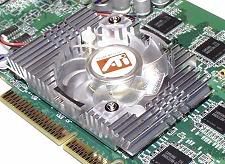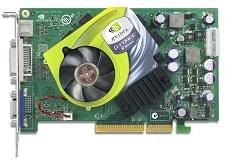Graphical conundra....

Geek Alert: This post is intended to be read by PC hardware enthusiasts only. Proceed at your own risk.
The last couple of weeks I've been thinking about upgrading my video card. I'm currently using a video card with an ATI Radeon 9600 Pro VPU. It's almost two years old, and despite the fact that it can still run any game with adequate speed and excellent image quality, it is starting to show its age. One of the games that I've been playing quite frequently recently, Battlefield 2 (see previous post here), is actually capable of bringing the 9600 Pro VPU to its knees when run at its maximum settings. Can you say choppy? I've even overclocked it in excess of 9600XT core speeds, yet the simple truth of the matter is that it just can't run Battlefield 2 with high quality settings at a framerate that is even close to being playable. Because of this, I just run it at medium settings at a resolution of 1280x960 with 2x antialiasing. These settings aren't the highest ones available, but set this way the game runs pretty well. So well that I even wonder to myself why I should even consider upgrading my video card.
One of the games that I've been playing quite frequently recently, Battlefield 2 (see previous post here), is actually capable of bringing the 9600 Pro VPU to its knees when run at its maximum settings. Can you say choppy? I've even overclocked it in excess of 9600XT core speeds, yet the simple truth of the matter is that it just can't run Battlefield 2 with high quality settings at a framerate that is even close to being playable. Because of this, I just run it at medium settings at a resolution of 1280x960 with 2x antialiasing. These settings aren't the highest ones available, but set this way the game runs pretty well. So well that I even wonder to myself why I should even consider upgrading my video card.
Well, the simple reason is that with graphics processing power, just like CPU power, memory, or hard disk storage, you can never have too much. :-) And I'm sure all the other power users out there would agree with me.
Unfortunately, buying a video card is no longer as easy to do as it was a couple of graphics processor generations ago. Then, you only need to concern yourselves with two main criterion: graphics processing power, and price. Nowadays, you also have to consider power consumption. Yes. You heard me right the first time. Power consumption. Some of today's mainstream and top-of-the-line video cards consume even more power than your computer's CPU. Increased power consumption inevitably results in higher heat output, and higher electrical bills, especially if you leave your computer on most of the time, like I do. I only made this realization after reading a comprehensive article on the power consumption characteristics of various video cards on X-bit labs.
Take for example my current video card, with its ATI Radeon 9600 Pro VPU. This VPU at default core and memory speeds consumes a paltry 8.69 watts at idle, and 18.38 watts while running a graphics intensive program (a 3D game for example). Contrast this to ATI's previous generation top-tier card, the ATI Radeon 9800 Pro. At default core and memory speeds, the 9800 Pro consumes 30.51 watts while idle. Active, it can draw up to 47.25 watts. Comparing the two VPUs side by side, the 9800 Pro consumes up to 3.5 times the power needed by a 9600 Pro at idle, and up to 2.5 times the power draw of a 9600 Pro when active. If you think that's a lot of power, the power consumption of a 9800 Pro just pales in comparison when compared to the power draw of NVIDIA's previous top-of-the-line video card, the GeForce FX 5950. While it only draws 20.43 watts at idle with default core and memory speeds, it can consume up to a scorching 73.54 watts when active. Now that's a lot of power however which way you look at it.
Choosing a video card used to be simpler then. Two years ago the 9600 Pro was the price-performance leader, and that's just about all you needed to know before you chose a card to buy. Nowadays, especially with high-end video cards drawing more than 70 watts of power, you may even be required to purchase a new power supply to accompany that brand-spanking-new video card of yours. Of course, if you have other high-end components in your PC, you'll be definitely needing a lot of electrical power to run it all. Using the criteria of graphics processing power, price, and now, power consumption, I have concluded that the video card possessing the best balance of all these characteristics at this point in time are video cards sporting the NVIDIA 6600GT GPU. Not only is this GPU more powerful than the Radeon 9800 Pro, or even its big brother the 9800XT (see benchmarks here), it is actually cheaper, and it consumes an acceptable 18.47 watts at idle, and 47.89 watts when active. While the active power consumption is about the same as the 9800 Pro, the idle power consumption is only half that of the 9800 Pro. And with significantly better performance to boot.
Using the criteria of graphics processing power, price, and now, power consumption, I have concluded that the video card possessing the best balance of all these characteristics at this point in time are video cards sporting the NVIDIA 6600GT GPU. Not only is this GPU more powerful than the Radeon 9800 Pro, or even its big brother the 9800XT (see benchmarks here), it is actually cheaper, and it consumes an acceptable 18.47 watts at idle, and 47.89 watts when active. While the active power consumption is about the same as the 9800 Pro, the idle power consumption is only half that of the 9800 Pro. And with significantly better performance to boot.
If you want a video card with the least power draw yet with satisfactory performance, a card with an ATI Radeon 9600 Pro or 9600XT VPU might be more to your liking, especially if you run your PC all the time. Its power draw is so small, that it doesn't even have an auxilliary power connector, unlike the top-end brutes. For most current games, this video card is fast enough.
If you want high end performance, be prepared to buy a beefier power supply as well. NVIDIA recommends a 480-watt power supply with its NVIDIA GeForce 6800 Ultra, and at least a 300-watt power supply with the 6600GT.
As for me, I think I can wait a wee bit longer before I take the plunge and upgrade my video card. Knowing how little power my current card eats up, how well it performs relatively speaking, and how the cost of electricity has been rising lately, the Radeon 9600 Pro doesn't seem to be all that bad anymore. At least, for the moment. :-)
Links:
Power Consumption of Contemporary Graphics Accelerators. Part I: Graphics Cards on ATI Chips
Power Consumption of Contemporary Graphics Accelerators. Part II: NVIDIA vs. ATI
Extreme Acceleration of NVIDIA GeForce 6600 GT
VGA Charts VII: AGP Update Summer 2005
Comments
We're one month old now! Thank you for helping us disseminate the information about our global pinoy teachers' network. We are professional Filipino Educators. We are going to inspire, be proactive, give hope, and go the extra mile.
MARAMING SALAMAT SA IYO!
I don't have a good experiece with ATI because the two ATI cards I bought I had installation problems.
Of course I solved them and I'm satisfied with them performance-wise once properly installed. I just think an average computer user will find the instalation problems I had difficult to hack.
Not so with Nvidia. They're very easy to install. I don't know if you had problems installing these ATI babies.
On second thought, I was still on Windows 98SE then. Perhaps that was the cause...
Well anyway, forgive my ramblings...
Used Win98 for the TNT, TNT2 and GF2MX, never really gave me any problems.
The GF4MX440 and the GF4Ti, I used with WinXP. I had a problem once with the GF4Ti, I had to figure out how to make it run at AGP8X. I traced the problem to a cheap power supply which couldn't generate enough power for the AGP slot.
As for ATI, I had a 9500, and my current 9600 Pro. Used them with WinXP. The drivers used to suck at first (some games had rendering errors) but as the drivers matured the problems went away.
I think at this point in time you're pretty well covered whether you decide to go with ATI or NVIDIA.
Don't worry about it, I enjoy your ramblings. Its not everyday I get to discourse with someone about video cards. I guess as a topic its probably too geeky for most. :-)
If anyone else wants to discuss video cards (or for that matter any other PC peripheral) I'm all ears. :-)
Cheers Atty! :-)